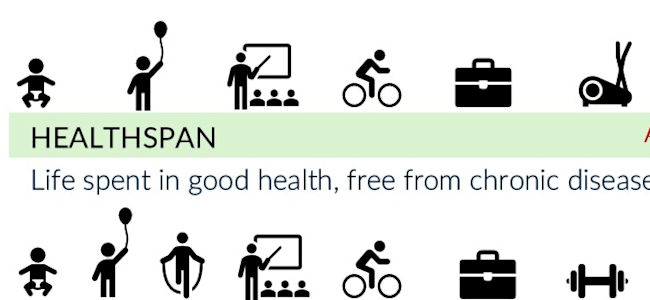In my previous blog I mentioned a new article that presented a global consensus on exercise recommendation for enhancing healthy ageing and extending our healthspan.
This article has been the most discussed publication in my networks, and truly provides the best summary of the research evidence for clinical practice, but also in the deeper cell level.
By summarizing a total of 693 research articles, the authors have written a text that can guide every practitioner and individual towards a longer and healthier life. You can access the whole article here.
Indeed, as you can see when you open the article, this journal of Nutrition, Health and Ageing, published on January 1, 2025 provides four additional texts on the same topic. Theme numbers like this become the cornerstones for change, guiding everyone to better practice.
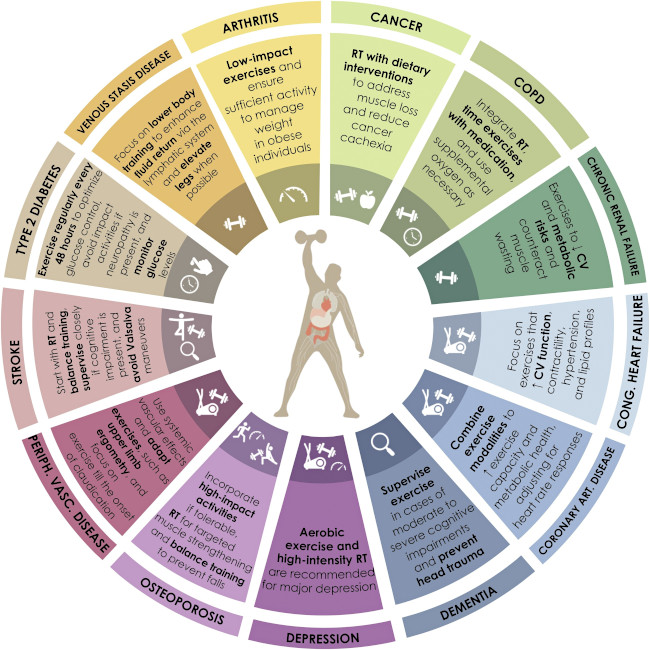
The article is filled with amazing images summarising and presenting the effect and prescription of exercise. Figure 1 alone summarises the exercise recommendations for 13 different illnesses, covering cardiovascular, musculoskeletal and metabolic diseases, among others. This image presents in one look the true value of “Exercise as Medicine”, with the benefits applicable for so many illnesses that are common in our society, influenced by our high level of inactivity.
Exercise, the “Magical Pill” providing significant effect in the prevention, treatment and management of many chronic diseases, has to be prescribed appropriately, paying attention to exercise modalities and intensities.
We can’t stop chronological and physiological aging, but we can change how we age. Ageing relates to physiological changes and functional decline over time, also including a higher risk of the presence of chronic diseases. However, as stated in this research summary – Lifestyle factors, notably physical activity (PA) and exercise, significantly modulate aging phenotypes. As the authors state:
“Physical activity and exercise can prevent or ameliorate lifestyle-related diseases, extend healthspan, enhance physical function, and reduce the burden of non-communicable chronic diseases including cardiometabolic disease, cancer, musculoskeletal and neurological conditions, and chronic respiratory diseases as well as premature mortality.”

Click here for High Resolution image.
Our training goals and modalities change as we age. In our younger years physical activity and exercise cover all modalities, but as we get older, the importance of strength training is emphasized. Another recent article, “The coming of age of age of resistance exercise as a primary form of exercise for health” (Phillips SM et al., ACSM Health and Fitness Journal, Dec 2023) discussed the importance of strength training as a primary modality as exercise towards better health.
Whilst in the past aerobic exercise has been considered the primary exercise modality, a growing pool of evidence supports the significant health effects of strength training. This article discusses many studies, including a meta-analysis of 16 prospective observational studies, with at least 2 years of follow-up, demonstrating that
“Any Resistance exercise (RE) is associated with a decrease in all-cause mortality compared with no RE. Encouragingly, the optimal dose for lowering the risk of all-cause mortality and cases of cardiovascular disease, cancer, and diabetes was shown to be as low as 30 to 60 minutes/week”.
Whilst both modalities matter, as seen in figure one and two, resistance training must be included in physical activity guidelines. As stated by the authors:
“We propose that Physical Activity guidelines make clear that there are situations where aerobic or resistance exercise are equally beneficial from a health standpoint. We also suggest that the same guidelines emphasize that some aspects of health, especially in older persons, are better served by engaging in resistance exercise.”
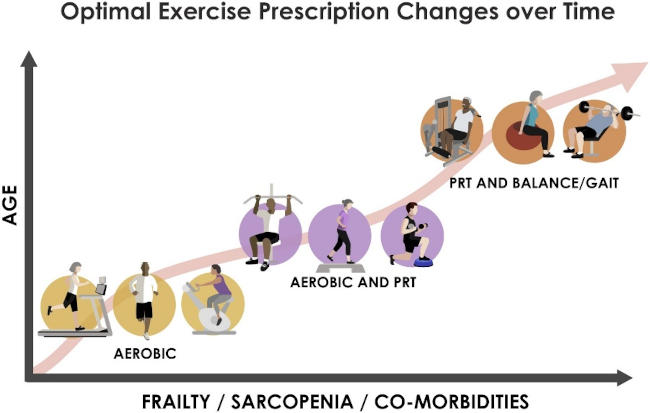
The consensus article (M. Izquierdo et al, JNHA 100401, 2025) summarises the age effect nicely (figure 3). Exercise prescription should align with function related requirements.
For older adults with severe frailty, the focus should be on physical requirements necessary for mobility. The exercise program should include Progressive Resistance Training (PRT), emphasizing basic movements such as sit-to-stand, or step negotiation, these being fundamental skills for lifting body weight and initiating movement.
As sufficient strength is gained, balance exercises must be included to maintain upright positions. Endurance training is finally included to support walking and other daily activities.
For the last year we have been discussing Healthspan, “The period of life spent in good health, free from the chronic diseases and disabilities of aging” (Kaeberlein, 2018, GeroSciece). Whilst Longevity is living longer, Healthspan is about living better, doing the things we like to do, living a life with high quality.
By including exercise in our lives we don’t just live longer,
but can minimise the years spent with disease.
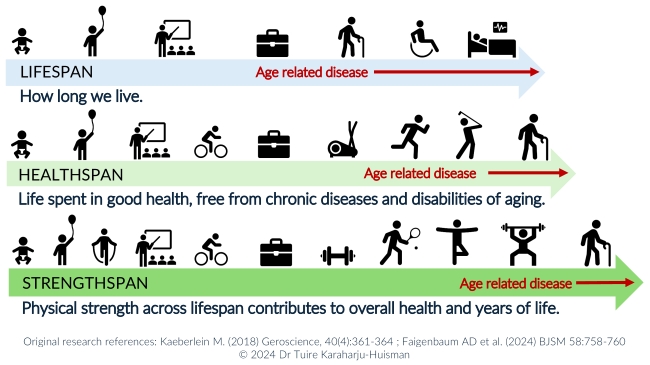
At the end of last year World Health Organisation published a report on the gap between Lifespan and Healthspan among 183 World Health Organization Member States (Garmany A, Terzic A, JAMA Network Open. 2024;7(12):e2450241), with the purpose of quantifying the Healthspan-Lifespan gap across the globe. The difference in life expectancy and health-adjusted life expectancy (ie. Healthspan-Lifespan gap) represents the number of years lived with disease or disability.
The results (figure 5) showed that The Healthspan-Lifespan gap has widened by 13% globally over the last 2 decades (2000 to 2019), extending from 8.5 to 9.6 years. These Healthspan-Lifespan gaps are also associated with the burden of noncommunicable diseases and total morbidity.
The US had the widest Healthspan-Lifespan gap at 12.4 years (24% larger than predicted based on expected lifespan), closely followed by Australia at 12.1 years with women having an average healthspan-lifespan gap 2.4 years greater than men.
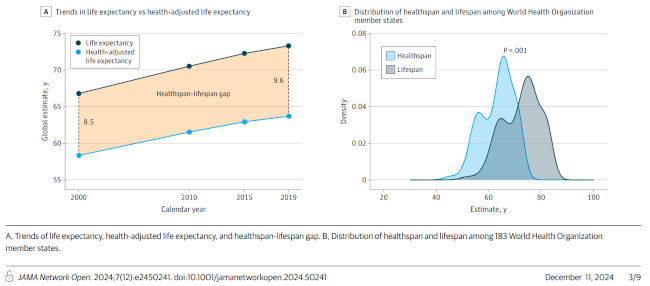
The widening Healthspan-Lifespan gap is a global trend, suggesting that although we are living longer, more of these years are spent burdened by disease. There is a clear need for proactive wellness-centric care systems.
At the end of last year, I was invited to take part in a Podcast, 100 not out, where the podcast hosts, wellness coach Marcus Pearce and Dr Damien Kristof invite guests to discuss all things about health, wellness and ageing well, trying to put more quality into the quantity of life.
It was such a pleasure to be the guest of episode 617 discussing Healthspan, Strengthspan and the many benefits of strength training. Our 20 minute planned chat turned to 45 minutes of chatting about the importance of muscles to our health.
Click here to see the video version of our chat “Strengthspan v Lifespan v Healthspan” with Marcus Pearce, Damien Kristof and Tuire Karaharju-Huisman; and you can find more about the podcast here.
To summarise – the research evidence is growing and guidelines are given on how to exercise the best when aiming at the best health at every age. Yet the WHO Survey shows that we are not doing the right thing, and indeed, Australia has sadly the second highest Healthspan – Lifespan gap. To stop this trend, we must keep on advocating for exercise, the right exercise, maximising everyone’s healthy years free of disease.
Best wishes,
Dr Tuire Karaharju-Huisman
Physiotherapist, Accredited Exercise Physiologist (ESSAM), PhD (Biomechanics)
Research Lead, Area Account Manager (Vic, Tas, SA, NT)

